National
Small Indian aid projects restart after a gap of five years
The budget for such small India-aided infrastructure projects at local level stands at Rs480 million.Prithvi Man Shrestha
After a gap of five years, projects under India’s Small Grant Development Project Scheme have restarted from the current fiscal year with the aid becoming part of the budgetary system.
While India through its embassy in Kathmandu had been giving grants for small projects at the local level since the scheme was launched in 2003 the Nepali government had been asking it to spend the money as part of its budgetary system.
The budget for such small India-aided infrastructure projects at local level stands at Rs480 million.
“It is the first time that Indian aid under the Small Development Project Scheme has been incorporated in the budget,” said Dil Bahadur Chhetry, under secretary at the international economic cooperation coordination division at the Finance Ministry.
The Cabinet on December 23 last year had approved a proposal of the Finance Ministry to implement the projects under the scheme by bringing Indian aid into the national budgetary system.
Chhetry said that the amount would go to local governments as a conditional grant to implement projects that will be selected later.
Various local governments have already recommended 67 projects to be implemented with the Indian aid.
As per the working procedure approved by the Cabinet, local governments will have to contribute 20 percent to implement the selected projects under the Small Development Project Scheme and a maximum of Rs 50 million can be spent per project from the Indian aid for a project.
Launched in November 2003, the projects are popularly known as ‘umbrella agreement’, on the basis of which the Indian Embassy had been extending assistance to various projects.
The scheme had courted controversy for Indian embassy funding to the project directly. It had been dubbed as an ‘instrument’ to wield Indian influence over local communities in Nepal.
The Cabinet on August 3 extended the umbrella agreement till 2023 by ensuring that Indian aid to implement projects under this scheme would come through the Nepali budgetary system.
According to Chhetry, it was extended with the provision that newly adopted modality would be maintained.
When asked for comment on the new system, Indian Embassy Spokesperson Abhishek Dubey said, “The embassy works with all the ministries, departments and agencies of GoN [Government of Nepal] to expeditiously implement all the development projects, in a consultative, cooperative, collaborative manner to share the benefit of these projects with people of the project areas.”
As the Indian aid has come through the budgetary system, it now falls under the purview of the Office of the Auditor General which will now audit how the local governments spent it.
Finance Ministry officials say that they don’t have a database on how much money was spent under the scheme since its inception in 2003 due to the direct nature of funding from the Indian embassy in the past.
Ever since the new constitution was promulgated in 2015, the government had been insisting that this Indian aid scheme should come under the budgetary system.
The constitution bars donors from providing funds directly to the local governments. After the scheme was renewed in 2014, no new projects had been implemented until early this year.
After the new modality was introduced, three new projects are being implemented.
“Two school projects in two local levels in Darchula and Dhanusha and the drinking water project at Pashupati Development Area In Kathmandu are currently being implemented,” said Ramesh Kadel, under secretary at the development assistance cooperation section at the Ministry of Federal Affairs and General Administration.
The three projects are now being implemented after the Ministry of Federal Affairs, the concerned local government and the Indian embassy signed tripartite agreements.
These three are among the 67 projects under consideration but in the case of others, there has been no progress since local governments have not submitted additional documents on the proposed projects that the Indian Embassy has sought, according to Kadel.




 15.12°C Kathmandu
15.12°C Kathmandu















